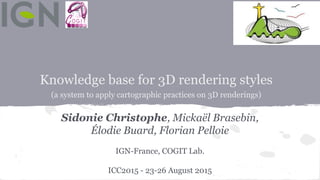Knowledge base for 3D rendering styles
- 1. Knowledge base for 3D rendering styles (a system to apply cartographic practices on 3D renderings) Sidonie Christophe, Micka├½l Brasebin, ├ēlodie Buard, Florian Pelloie IGN-France, COGIT Lab. ICC2015 - 23-26 August 2015
- 2. Motivation To adapt 3D renderings to urban projects
- 3. Motivation To adapt 3D renderings to urban projects Ō×ö to control 3D styles Ō×ö to smoothly navigate between 3D styles
- 4. Motivation Mixing and navigating between 3D styles for building representation (Hoarau 2015) (Semmo & D├Čllner 2014) (Biljecki 2014; Semmo et al. 2013)
- 5. Aim of the talk 3D Data GUI Formalized styles Interpolation method Production of intermediate mixes User with task(s)
- 6. Aim of the talk 3D Data GUI Formalized styles Interpolation method Production of intermediate mixes User with task(s) Focus
- 7. Approach 1. Style Formalization: 2D style model to 3D style model? 2. Analysis and annotation of 3D renderings 3. 3D Knowledge base production
- 9. Style formalization Rendering process driven by style description Ex.: expressive, photo-realist, etc. Ex.: textures Ex.: sea, roads, ortho-image Ex.: color, width, tiledistribution
- 10. Style formalization Existing formalisms to describe ŌŚÅ 2D styles (OGC SLD/SE) ŌŚÅ 2D SLD extension ŌŚÅ 3D SLD
- 11. Style formalization Model design for style formalization based on represented features External data
- 12. Style formalization -> To identify controllable 3D graphic parameters External data
- 13. Style formalization -> To identify representative and recognizable 3D categories of styles External data
- 14. Analysis of 3D renderings
- 15. Analysis of 3D renderings 15 3D renderings manually annotated: 1. Overall categorization into categories 2. Feature extraction 3. Graphic parameters extraction
- 16. Analysis of 3D renderings Level of Detail (+/-) and (Non)Photo-Realism
- 17. Analysis of 3D renderingsLevel of detail photo-realism
- 18. Analysis of 3D renderings Windows Wall Features Graphic parameters TexturesVisual variables StyleCategory ex.: non- photorealistic pencil draw style
- 19. Analysis of 3D renderings Windows Wall Features Graphic parameters TexturesVisual variables gridtexture (4,2), L=x, l=y white background, black outline lŌĆÖ StyleCategory ex.: photorealistic
- 20. Analysis of 3D renderings - a set of annotated 3D renderings - for each visible feature, a set of graphic parameters - each 3D rendering into a category -> to link graphic parameters and 3D categories of style
- 22. Knowledge base production Step 1: manual evaluation of a set of renderings Ō×ö Can be realized by external contributors 3D Rendering 3D Rendering 3D Rendering 3D Rendering 3D Rendering 3D Rendering 3D Rendering 3D Rendering 3D Rendering 3D Rendering
- 23. Step 2: extraction of relevant information Ō×ö Importance of a feature (i.e. screen size) Ō×ö Relationship between features (i.e. spatial relation to assess saliency) Knowledge base production
- 24. Step 3 : extraction of patterns Ō×ö Inherent characteristics of graphic parameters ex.: pencil-like strokes make think about a NPR rendering (level of stylisation) Ō×ö Relation between a feature and graphic parameters ex.: unconventional colors used for some features make think about a NPR rendering (level of realism) Ō×ö Relation between represented features ex.: same representation for touching features tends to decrease the level of detail of a representation (level of contrasts) Knowledge base production
- 25. Conclusion & Perspectives Very first steps towards a 3D style model - Is 2D knowledge transferable to 3D? Ō×ö Begin of long term thoughts about 3D semiotics for better practices (to simplify design & implementation tasks) Ō×ö Interpolation between 3D styles (to simplify usersŌĆÖ tasks) Ō×ö Understanding of 3D styles vs. users vs. tasks?
- 26. Thank you for your attention! sidonie.christophe@ign.fr

























